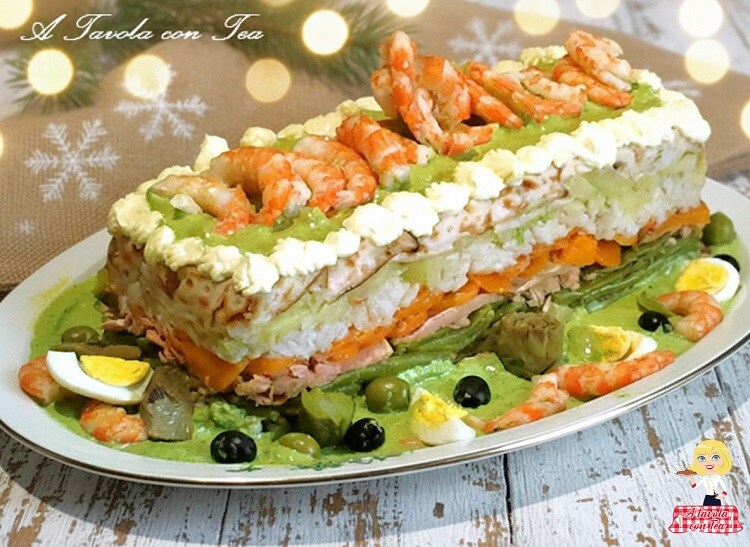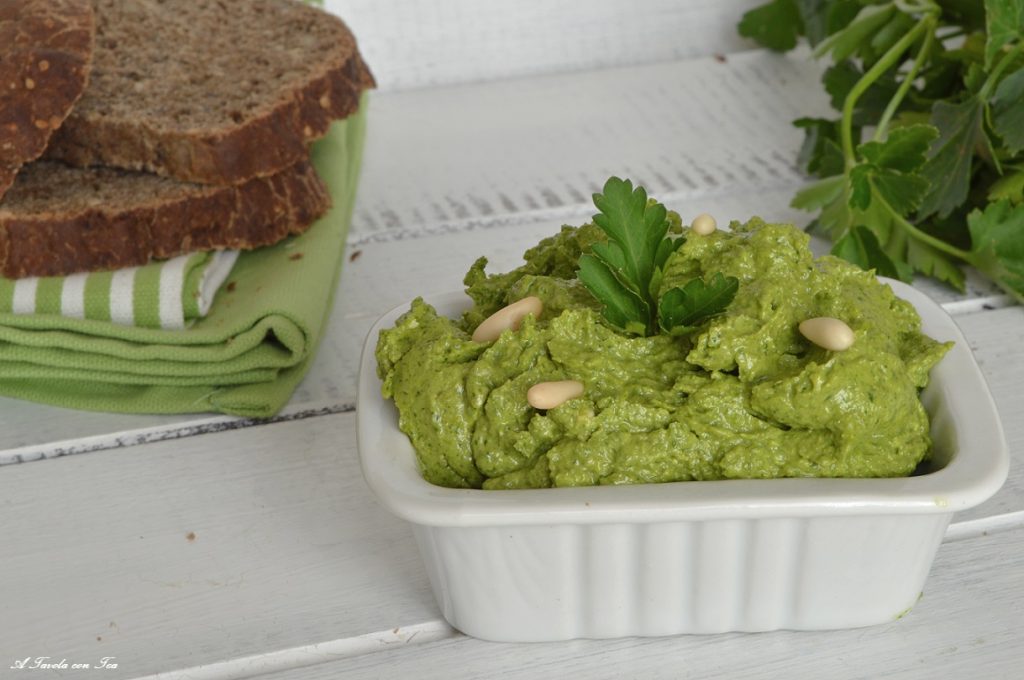CAPPON MAGRO RECIPE with Genoese Salsa Verde
Cappon magro with Genoese salsa verde is one of the most renowned recipes of traditional Ligurian cuisine: the typical dish for special occasions, especially at Christmas.
A true triumph of FISH and VEGETABLES, the queen of “mixed salads” featuring an endless variety of shellfish, fish, crustaceans, and vegetables accompanied by the incomparable Genoese Salsa Verde (not to be confused with Piedmontese Salsa Verde) tasty and light.
I confess that Cappon Magro is without a doubt my favorite recipe of all typical Genoese preparations to the point of being the main dish and always present in our home not only at Christmas and New Year’s but even for my birthday.
A traditional recipe of Ligurian and Genoese cuisine in particular with humble origins because it was the recovery dish of fishermen and sailors who used the mix of unsold fish and crustaceans at the end of the day to which they added the classic Sailor’s Biscuit.
Over time, Cappon Magro has evolved and improved, becoming certainly one of the most spectacular preparations of Genoese Cuisine.
Like all traditional recipes, there are many versions, the recipe we will prepare today for Cappon Magro is the original recipe of my family, passed down by my grandmother.
In this recipe, I used vegetables such as potatoes, green beans, carrots, scorzonera, and red beet while for fish: gurnard, shrimp, tuna, and octopus and completed everything with the inevitable Genoese salsa verde, boiled eggs, and Sailor’s Biscuit.
- GENOESE BASIL PESTO also with Blender and trick to prevent leaves from darkening
- Foolproof FOCACCIA recipe homemade easy and quick
- Focaccia with Recco cheese
- Spinach and ricotta ravioli with walnut sauce – traditional recipe
- LOW GENOESE PANDOLCE ORIGINAL RECIPE with which I won the Pandolce Championship

- Difficulty: Medium
- Cost: Costly
- Preparation time: 4 Hours
- Portions: 8
- Cooking methods: Stove
- Cuisine: Italian
- Seasonality: New Year's Eve, Christmas
- Energy 418.23 (Kcal)
- Carbohydrates 16.24 (g) of which sugars 4.10 (g)
- Proteins 21.29 (g)
- Fat 30.73 (g) of which saturated 2.83 (g)of which unsaturated 23.06 (g)
- Fibers 3.06 (g)
- Sodium 199.71 (mg)
Indicative values for a portion of 150 g processed in an automated way starting from the nutritional information available on the CREA* and FoodData Central** databases. It is not food and / or nutritional advice.
* CREATES Food and Nutrition Research Center: https://www.crea.gov.it/alimenti-e-nutrizione https://www.alimentinutrizione.it ** U.S. Department of Agriculture, Agricultural Research Service. FoodData Central, 2019. https://fdc.nal.usda.gov
Ingredients
- 2 cups potatoes
- 2 cups green beans
- 1 scorzonera (or cauliflower)
- 2 cups carrots
- 1 red beets, cooked, boiled
- 1 lb gurnard (if found better use Capon Fish)
- 1 cup shrimp (or scampi)
- 7 oz tuna belly (or canned tuna)
- 5 oz octopus (carpaccio)
- 1 sailor's biscuit (or unleavened bread)
- 1 tablet gelatin
- to taste red wine vinegar
- 2 leaves bay leaf
- 4 berries juniper
- to taste dry white wine
- 3.5 oz parsley (100 g of leaves are about 300 g bunches)
- 1 clove garlic
- 1 egg (hard-boiled)
- 4 pickled gherkins
- 1 crumb (soaked in red vinegar)
- 4 green olives (pitted)
- 0.7 oz capers
- 2 fillets anchovies in oil
- 0.7 oz pine nuts
- 1 cup sunflower oil
- mayonnaise
- shrimp (or prawns)
- pickled gherkins (or artichokes in oil)
- olives (green and/or black)
Tools
- Pot
- Basin
Steps
GELATIN I note that some recipes do not include the use of gelatin: I chose to brush each layer with a little of the preparation to have a more “stable” and beautiful Cappon Magro, but you are completely free not to use it. To prepare the gelatin, put 250 ml of water in a pot and bring to a boil. Then add the gelatin tablet and stir until completely dissolved. Add another 250 ml of cold water. The gelatin is ready to use.
Pour into the blender glass oil, pine nuts, capers, anchovies, gherkins, garlic, egg, squeezed crumb, and blend for 10 seconds. Gradually start adding parsley leaves, continuing to blend until you get a smooth sauce. Let it rest in the refrigerator for 24 hours before using.

Clean all the vegetables. Peel the scorzonera and carrot with a peeler. Remove the ends from the green beans. Wash the potatoes but do not peel them. Steam them separately in salted water. They all have different cooking times. Drain when they are tender but still firm. Once cooked, slice them all thinly except for the green beans. Peel the beetroot and slice it thinly.
Put in a pot: water, wine, bay leaf, and some juniper berries, and bring to a boil. Insert the whole capon fish and simmer for about 20 minutes, then drain, remove the head, skin, and backbone, and shred with your hands. Blanch the shrimp tails for a few minutes and peel them. As shellfish, you can use boiled Octopus (recipe here) or Octopus Carpaccio (recipe here) which if you don’t feel like preparing at home, you can buy ready-made at the supermarket.
Dissolve the gelatin in half a liter of water and boil for 5 minutes, then let cool. Line a baking dish with plastic wrap, leaving the ends long to make it easier to remove from the mold later.
Put a very thin layer of Gelatin on the bottom, then one of Genoese Salsa Verde. For the next layer, use unleavened bread (in Genoa the Sailor’s Biscuit) slightly dipped in water and red wine vinegar over a thin brushing of gelatin and then again salsa verde.Continue the layers in this way (the order can be different): 1 OCTOPUS or Octopus carpaccio – 2 SCORZONERA then brush with gelatin and salsa verde – 3 TUNA fillets in oil or belly – 4 aligned GREEN BEANS then brush with gelatin and salsa verde – 5 CAPON FISH – 6 layer of CARROTS brush with gelatin and salsa verde – 7 SHRIMP or SCAMPI tails – 8 BOILED POTATOES and brush with gelatin and salsa verde – 9 last layer of UNLEAVENED BREAD dipped in water and vinegar.
Now that you have composed the layers of Cappon Magro, close the ends of the plastic wrap, place a weight on top, and refrigerate for at least 24 hours. After the resting time, you can plate and decorate the Cappon Magro. Take a serving dish and make a thin layer of salsa verde, place the terrine in which you prepared the cappon magro on top, and remove the terrine. Decorate it with GENOESE SALSA VERDE and Mayonnaise (the recipe can be found HERE) and decorate as you like with Prawn tails, Scampi, and/or boiled Vegetables. It will be a triumph of fish and vegetables, almost a shame to cut it!

STORAGE
Cappon magro keeps in the fridge for two days. You can freeze it if all the frozen ingredients you bought are cooked beforehand.
NOTES
SAILOR’S BISCUIT The Sailor’s Biscuit is a dry bread shaped like a flattened focaccia that must be soaked in water and vinegar, but if you can’t find it, you can use unleavened bread or slices of toasted homemade bread.
VEGETABLES You can change the vegetables and, for example, use cauliflower, fennel, or celery.
FISH Usually, capon fish is used, which can be replaced with Scorpionfish or other fish with white and firm meat.
PRESENTATION IDEAS Cappon Magro can be placed in a terrine like mine or even in a salad bowl, and it will take the appearance (once inverted) of a half-sphere or even served as a single portion. Lately, in restaurants, it is also served in a deconstructed version as if it were a fish and vegetable salad.
CURIOSITIES
The Cappon Magro recipe boasts a long and ancient tradition. There are several hypotheses about the origin of its name: it could derive from the use of capon fish (gurnard or scorpionfish) or the fact that it was consumed as a lean dish instead of the meat Capon on Christmas Eve, or from the French word “chapon” which indicates a toasted bread crouton rubbed with garlic and used for soups. The origins of Cappon Magro, today considered one of the most spectacular and sumptuous preparations of Genoese and Ligurian cuisine in general, are actually humble. It was considered the poor dish of sailors and today we would call it a recycling recipe, using the leftovers of catch and sumptuous banquets to create a fish and vegetable salad.

